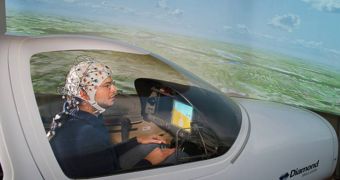Before anyone starts giggling at the sight of the funny hat the guy pictured above is wearing (although, truth be told, some giggles are in order), it must be said that the man's choice of headwear is not a classic case of fashion gone terribly wrong.
On the contrary, the pilot sacrificed himself and put that hat on for the sake of science. More precisely, he did so to help demonstrate the feasibility of the idea that human thoughts alone could one day fly planes.
Science Daily tells us that the possibility to rely on thoughts to control aircraft movements is now being studied as part of a project dubbed Brainflight, which the European Union agreed to fund.
Specialists with the Institute for Flight System Dynamics of the Technische Universität München in Germany claim to have made significant progress on this research project.
They say that, simply by thinking commands, several test subjects with varying levels of flight experience not only managed to stay on course, but performed so well that they would have probably passed a flying license test.
“One of the subjects was able to follow eight out of ten target headings with a deviation of only 10 degrees,” says aerospace engineer Tim Fricke.
Granted, the folks who took part in these experiments did not actually get aboard a plane and try to control it with their mind. Thus, what they did was use their brain to try and control an aircraft during flight simulator tests.
Still, the Technische Universität München specialists say that the test subjects performed well enough in these tests to prove that, all things considered, the idea of using human thoughts to fly planes is not as far-fetched as some think it to be.
“A long-term vision of the project is to make flying accessible to more people. With brain control, flying, in itself, could become easier,” explains aerospace engineer and study leader Tim Fricke.
“This would reduce the work load of pilots and thereby increase safety. In addition, pilots would have more freedom of movement to manage other manual tasks in the cockpit,” the Technische Universität München specialist adds.
In case anyone was wondering, human-to-plane communication is made possible by so-called electroencephalography (EEG) electrodes which stick to an individual's head and keep tabs on brain waves.
A special algorithm put together by researchers with the Department of Biological Psychology and Neuroergonomics at the Berlin Institute of Technology helps decipher resulting electrical signals and makes it possible for them to be converted into useful commands.

 14 DAY TRIAL //
14 DAY TRIAL //